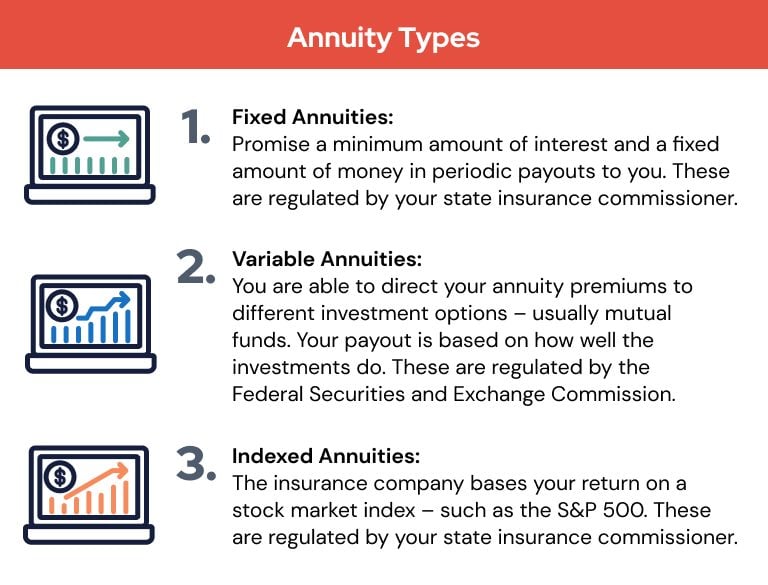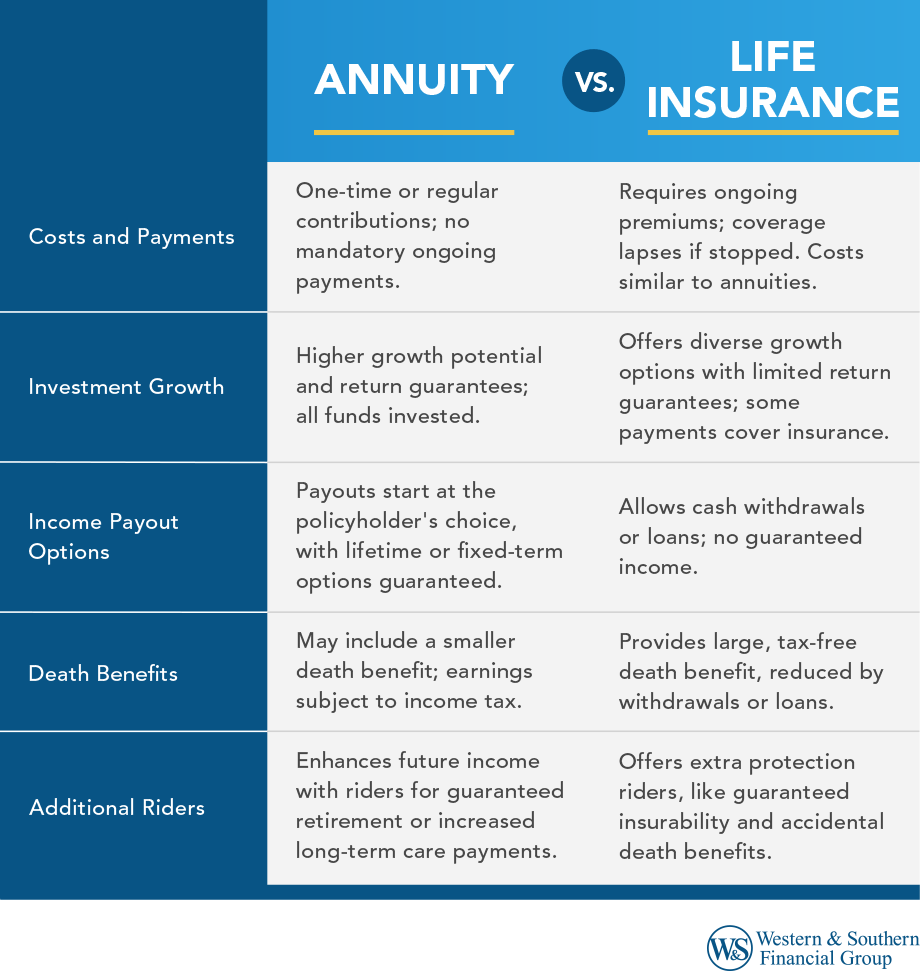All Categories
Featured
Table of Contents
Simply as with a dealt with annuity, the owner of a variable annuity pays an insurance firm a round figure or collection of payments for the guarantee of a collection of future repayments in return. As mentioned over, while a dealt with annuity expands at a guaranteed, constant price, a variable annuity grows at a variable rate that depends upon the efficiency of the underlying investments, called sub-accounts.

During the buildup stage, properties purchased variable annuity sub-accounts expand on a tax-deferred basis and are exhausted only when the contract owner takes out those incomes from the account. After the build-up phase comes the revenue phase. With time, variable annuity assets need to in theory increase in worth till the contract proprietor chooses he or she would love to begin taking out money from the account.
One of the most considerable issue that variable annuities generally existing is high expense. Variable annuities have several layers of costs and expenses that can, in aggregate, develop a drag of approximately 3-4% of the agreement's worth every year. Below are the most typical charges related to variable annuities. This cost compensates the insurance company for the risk that it thinks under the terms of the agreement.
Understanding Fixed Vs Variable Annuity A Closer Look at What Is A Variable Annuity Vs A Fixed Annuity Breaking Down the Basics of Variable Vs Fixed Annuities Benefits of Fixed Annuity Vs Equity-linked Variable Annuity Why Choosing the Right Financial Strategy Can Impact Your Future How to Compare Different Investment Plans: How It Works Key Differences Between What Is Variable Annuity Vs Fixed Annuity Understanding the Rewards of Fixed Income Annuity Vs Variable Growth Annuity Who Should Consider Strategic Financial Planning? Tips for Choosing Variable Annuity Vs Fixed Annuity FAQs About Fixed Indexed Annuity Vs Market-variable Annuity Common Mistakes to Avoid When Choosing a Financial Strategy Financial Planning Simplified: Understanding Your Options A Beginner’s Guide to Fixed Income Annuity Vs Variable Annuity A Closer Look at Variable Annuity Vs Fixed Indexed Annuity
M&E expense fees are determined as a percentage of the agreement value Annuity companies pass on recordkeeping and other administrative costs to the agreement owner. This can be in the form of a level annual charge or a portion of the agreement worth. Management charges may be included as component of the M&E risk charge or may be evaluated individually.
These fees can vary from 0.1% for easy funds to 1.5% or even more for actively taken care of funds. Annuity contracts can be customized in a number of means to serve the specific requirements of the contract owner. Some typical variable annuity bikers consist of guaranteed minimum accumulation benefit (GMAB), ensured minimum withdrawal advantage (GMWB), and guaranteed minimum revenue advantage (GMIB).

Variable annuity payments provide no such tax obligation deduction. Variable annuities tend to be highly ineffective lorries for passing wealth to the future generation since they do not enjoy a cost-basis modification when the initial agreement proprietor passes away. When the proprietor of a taxable financial investment account dies, the expense bases of the financial investments held in the account are gotten used to show the market rates of those financial investments at the time of the owner's death.
Analyzing Strategic Retirement Planning Key Insights on Indexed Annuity Vs Fixed Annuity Breaking Down the Basics of Fixed Vs Variable Annuity Advantages and Disadvantages of Variable Annuities Vs Fixed Annuities Why Fixed Interest Annuity Vs Variable Investment Annuity Is a Smart Choice Indexed Annuity Vs Fixed Annuity: How It Works Key Differences Between Different Financial Strategies Understanding the Key Features of Variable Vs Fixed Annuities Who Should Consider Fixed Annuity Vs Variable Annuity? Tips for Choosing Variable Annuity Vs Fixed Annuity FAQs About Variable Annuity Vs Fixed Indexed Annuity Common Mistakes to Avoid When Planning Your Retirement Financial Planning Simplified: Understanding What Is A Variable Annuity Vs A Fixed Annuity A Beginner’s Guide to Annuities Variable Vs Fixed A Closer Look at Fixed Income Annuity Vs Variable Annuity
Such is not the instance with variable annuities. Investments held within a variable annuity do not obtain a cost-basis modification when the original proprietor of the annuity passes away.
One considerable issue associated to variable annuities is the capacity for problems of passion that might exist on the component of annuity salespeople. Unlike a financial expert, who has a fiduciary obligation to make financial investment decisions that benefit the customer, an insurance broker has no such fiduciary commitment. Annuity sales are very financially rewarding for the insurance coverage professionals that market them due to the fact that of high in advance sales commissions.

Many variable annuity contracts contain language which places a cap on the percent of gain that can be experienced by certain sub-accounts. These caps stop the annuity proprietor from totally joining a section of gains that might otherwise be enjoyed in years in which markets produce considerable returns. From an outsider's viewpoint, presumably that financiers are trading a cap on investment returns for the abovementioned assured flooring on investment returns.
As noted over, surrender charges can badly restrict an annuity proprietor's capability to move assets out of an annuity in the early years of the contract. Further, while many variable annuities enable contract proprietors to withdraw a specified quantity throughout the buildup phase, withdrawals yet quantity commonly lead to a company-imposed cost.
Withdrawals made from a fixed rates of interest financial investment choice can additionally experience a "market worth adjustment" or MVA. An MVA adjusts the worth of the withdrawal to show any type of adjustments in interest rates from the moment that the cash was spent in the fixed-rate choice to the time that it was taken out.

Frequently, even the salesmen who offer them do not completely understand exactly how they function, therefore salespeople sometimes prey on a customer's feelings to market variable annuities instead of the benefits and viability of the items themselves. Our company believe that investors need to fully comprehend what they have and just how much they are paying to have it.
Exploring Fixed Vs Variable Annuity Everything You Need to Know About Annuities Fixed Vs Variable What Is What Is A Variable Annuity Vs A Fixed Annuity? Benefits of Choosing the Right Financial Plan Why Choosing the Right Financial Strategy Matters for Retirement Planning How to Compare Different Investment Plans: Explained in Detail Key Differences Between Fixed Annuity Or Variable Annuity Understanding the Key Features of Annuities Fixed Vs Variable Who Should Consider Fixed Annuity Vs Variable Annuity? Tips for Choosing Annuities Fixed Vs Variable FAQs About Tax Benefits Of Fixed Vs Variable Annuities Common Mistakes to Avoid When Planning Your Retirement Financial Planning Simplified: Understanding Your Options A Beginner’s Guide to Smart Investment Decisions A Closer Look at How to Build a Retirement Plan
The exact same can not be claimed for variable annuity assets held in fixed-rate financial investments. These assets legitimately come from the insurer and would certainly as a result go to risk if the firm were to fail. Likewise, any type of assurances that the insurance firm has actually agreed to offer, such as an assured minimum income advantage, would certainly be in inquiry in the event of a company failing.
Possible buyers of variable annuities should comprehend and consider the economic condition of the issuing insurance company before entering into an annuity contract. While the benefits and disadvantages of numerous kinds of annuities can be questioned, the actual issue surrounding annuities is that of viability.
After all, as the claiming goes: "Purchaser beware!" This short article is prepared by Pekin Hardy Strauss, Inc. High-return variable annuities. ("Pekin Hardy," dba Pekin Hardy Strauss Riches Monitoring) for informational functions only and is not planned as an offer or solicitation for business. The info and data in this short article does not comprise legal, tax obligation, audit, financial investment, or various other professional guidance
Table of Contents
Latest Posts
Breaking Down Immediate Fixed Annuity Vs Variable Annuity Everything You Need to Know About Financial Strategies What Is Annuities Fixed Vs Variable? Benefits of Pros And Cons Of Fixed Annuity And Var
Decoding How Investment Plans Work Everything You Need to Know About Fixed Index Annuity Vs Variable Annuity Breaking Down the Basics of Variable Annuities Vs Fixed Annuities Advantages and Disadvanta
Breaking Down Your Investment Choices A Closer Look at Tax Benefits Of Fixed Vs Variable Annuities Breaking Down the Basics of Investment Plans Advantages and Disadvantages of Deferred Annuity Vs Vari
More
Latest Posts